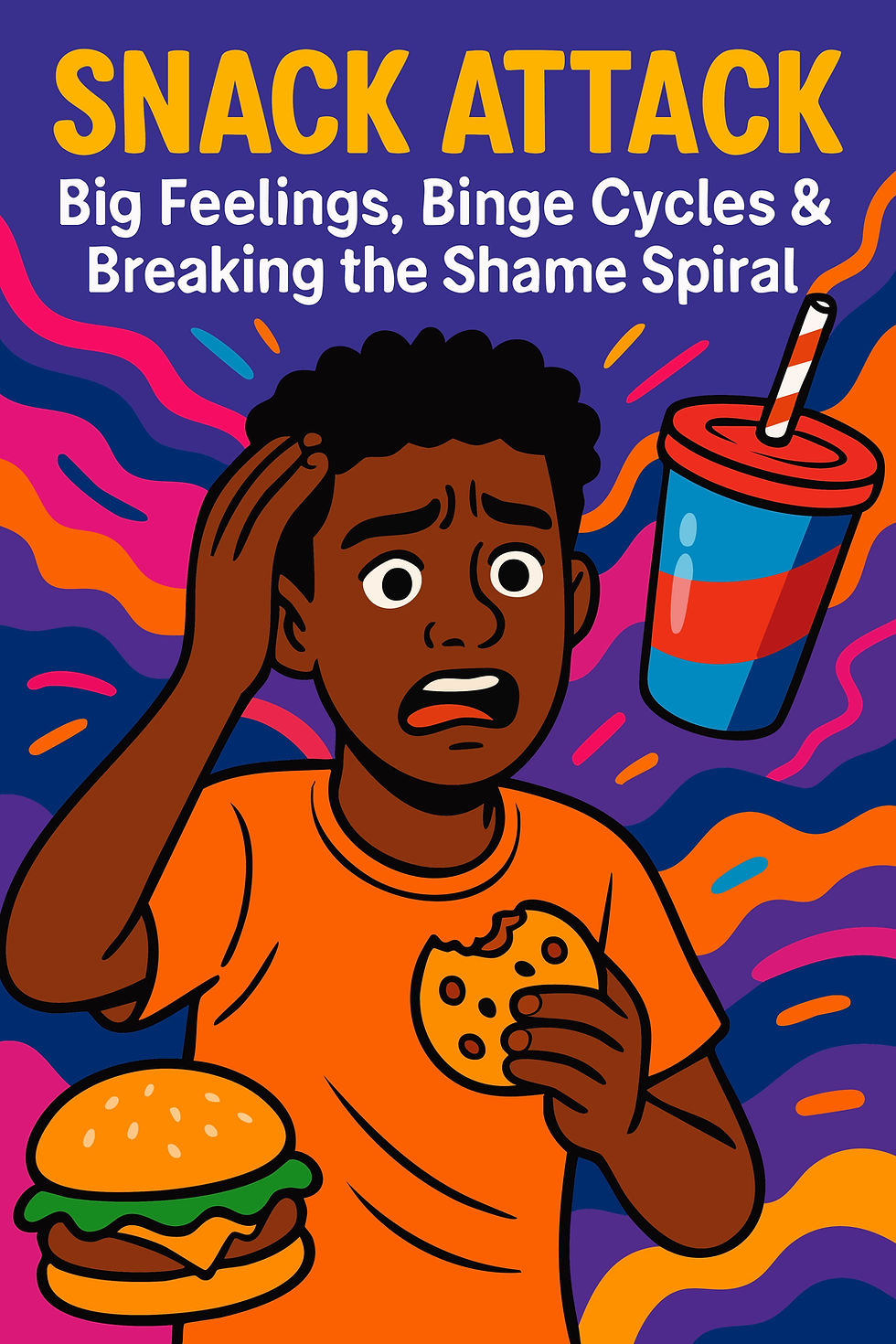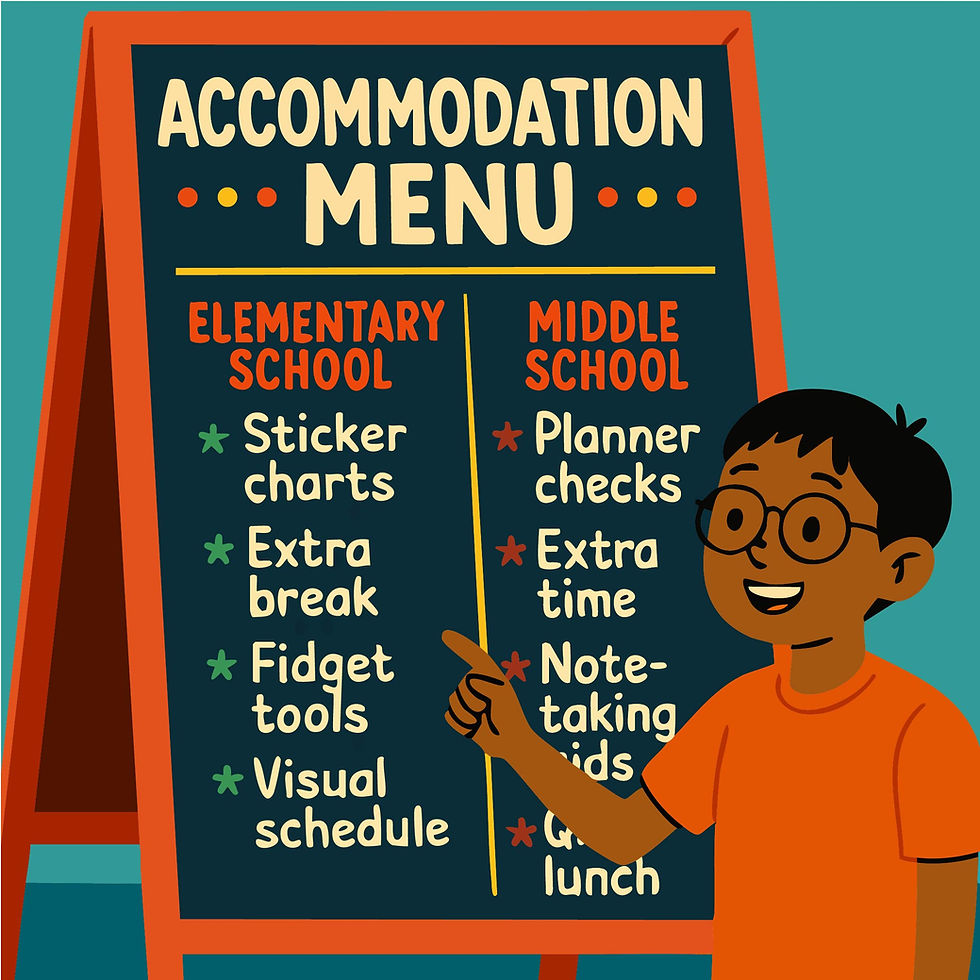Snack Attack: ADHD, Dopamine & the Hidden-Twinkie Phenomenon (Part I)
- Tara Gentile
- Sep 9
- 5 min read
Updated: Sep 16
ADHD brains, meet food. Food, meet chaos. Everyone, be cool.
Why your pantry keeps disappearing
If "mindful eating" is a slow yoga flow, ADHD eating is Zumba in a lightning storm. This isn't a moral failure; it's neurology. Once you see how the wiring works, the weird stuff — stealing, hiding, hoarding, bingeing — stops looking "bad" and starts looking predictable. Which is great news, because predictable things can be supported.
Roadmap: We'll hit the big levers (dopamine/reward, impulsivity, emotional regulation, executive function, hyperfocus, meds) and show how each looks in kids → teens → adults—with Kei's greatest hits slotted right where they belong.

Dopamine & the ADHD Snack Hustle
Let's talk about the real ringleader behind ADHD eating chaos: dopamine. Everyone calls it the "pleasure chemical", but that's selling it short. It’s less like a cupcake and more like a push notification: "Ooooh, that cupcake might make us happy. Go. Get. It. NOW."
Here's the catch for ADHD brains:
They start with less dopamine available than neurotypical brains.
Their reward circuits (frontal lobe + striatum) don’t fire the same way.
That means they live in a dopamine drought — and the brain compensates by chasing quick, external boosts.
Those boosts? Oh hey, besties:
Sugar
Salt
High-fat comfort food
Soda fizz
Basically anything labeled: "don't eat this whole bag at once."
Why ADHD Brains Chase Snacks Like It's a Sport
When dopamine runs low, fast rewards feel like oxygen. Highly palatable foods — think sweet, salty, fizzy, crunchy — hit the reward system like a slot machine jackpot. The ADHD brain goes, "YES. THIS. DO IT AGAIN." And so, it does.
But this isn't just about food cravings. It's about how the brain learns:
Early childhood → Quick hits rule
Impulse wins over logic every time. If a snack is within arm's reach, it's fair game.
Case in Point: The Great Dumpster-Dive Twinkie Caper
First grade cafeteria. Kei spots half a Twinkie and a bag of 'hit-the-ground' chips sitting right on top of the trash can... and goes for it. Zero hesitation. Zero shame. Just pure snack opportunism at work. ADHD brain logic: “Fast sugar = happy brain. Do it. Now.”
Elementary → Methodical snack ops begin
Access + privacy = escalation. This is where bedroom snack cartels are born. Food migrates from backpacks to dresser drawers to bathroom cabinets. If dopamine is missing, Kei’s got a stash plan.
Post-medication → Evening kitchen heists
Stimulant meds suppress appetite during the day… but once they wear off? The hunger floodgates open.
Teens & adults → Same wiring, different access
Now it’s late-night raids, oversized DoorDash orders, and “accidentally” inhaling the family-size bag of Doritos during an email sprint. Same dopamine chase, bigger snack budgets.
Micro-Shift That Helps
Pre-plan legit "fun foods."
Sounds counterintuitive, but scheduling treats
reduces bingeing because the ADHD brain stops panic-foraging.
When you know ice cream will happen Friday night,
you don’t need to smuggle Oreos under your pillow on Wednesday.

Impulsivity & Food Hiding: "Act First, Think… Eventually"
If dopamine drives the craving, impulsivity slams the gas pedal. ADHD brains often have challenges with inhibitory control (pausing before acting) and delay discounting (choosing smaller-now rewards over bigger-later ones). Translation: "Eat the cookie now. Regret is a future problem."
This isn’t lack of discipline. It’s brain wiring. And it changes with age — not because kids “grow out of it,” but because the impulsivity just gets smarter.
Stage 1: Little Kids (Ages 5–8) — "See Snack, Eat Snack"
Impulsivity in early childhood is pure chaos mode. No planning, no strategy — just instant action. If the cupcake exists, it’s happening. Full stop.
What you don’t see yet? Shame. Little kids haven’t learned to hide the behavior; they just get caught red-handed (or blue-tongued if there’s frosting involved).
Case in Point: The Dangerous Case of Floor Candy
Kei and I are shopping at Big Lots. I turn away for thirty seconds — thirty! — and when I look back, there's Kei, chewing...something. Turns out, my sweet little dopamine gremlin had spotted candy on the floor and popped it straight into his mouth before my brain could even process what was happening.
Cue me going full snack-SWAT mode, prying his jaw open like a bomb squad trying to disarm a sugar-coated landmine. Final verdict? Some questionable cotton-candy-flavored sludge — not poison, thank God — but my heart still ran a full marathon in 8.2 seconds.
Classic ADHD impulsivity: see snack, eat snack, no pause button installed.
Stage 2: Big Kids (Ages 8–12) — The Birth of the Snack Cartel
This is when impulsivity starts evolving. ADHD brains still "want the hit", but now they realize adults don’t approve of the "how." So the behavior goes underground.
What’s happening neurologically:
Dopamine still drives craving.
Impulse control is slightly better… but now the prefrontal cortex says, "If Mom sees, I'm toast."
Enter: planning in service of the impulse.
This is also the stage where impulsivity and emotions start to team up. ADHD kids begin to notice judgment around food rules, and shame sneaks in. That shame can actually make the behavior worse — because the more ‘forbidden’ the snack feels, the more the ADHD brain craves it. That’s where impulsivity starts blending with emotional dysregulation — and where hiding, stashing, and secret eating often begin.
Stage 3: Middle School / Early Teens (Ages 12–16) — Stealth Mode Activated
By now, impulsivity hasn't disappeared — it's just wearing a hoodie and carrying better strategies. ADHD brains start pairing dopamine hunger + sneakier execution.
Combine this with medication rebound:
Stimulants suppress hunger during the day.
Meds wear off around dinner.
Result = binge danger zone. Kei often went from zero appetite to devouring everything in sight in one sitting.
At this age, ADHD kids often juggle intense food cravings + shame spirals. They want the dopamine hit and to avoid confrontation, so secrecy deepens.
Stage 4: Teens / Adults (Ages 16+) — Impulse in Disguise
Here’s the big myth: "People grow out of ADHD impulsivity." Nope. It just trades juice boxes for whole bags of chips and a DoorDash account.
What changes:
More independence = fewer external limits.
More emotional eating: ADHD teens and adults often soothe stress, rejection, or boredom with food.
Impulsivity goes digital → midnight DoorDash orders, Amazon snack hauls, eating "just a bite" that somehow turns into inhaling the entire charcuterie board.
The wiring hasn’t changed — only the access.
How Impulsivity + Shame Collide
Over time, impulsive eating patterns can spiral into secrecy and guilt. And here's the kicker: shame makes the behavior worse. When ADHD kids feel judged for food behaviors, they don’t stop — they hide better. That secrecy fuels stress, which drives more impulsive eating, and the cycle loops.
Micro-Shifts That Help
Name the impulse, don’t shame it.
"Your brain wants a fast reward right now — let’s find an okay snack”
works better than "Why are you sneaking food again?"
Create predictable snack times.
ADHD brains relax when treats are guaranteed.
Keep dopamine-friendly options visible.
Protein packs, fruit cups, crunchy veggies —
make the "yes" snacks easy.
Unpack the shame gently.
Talk about food openly; snacks aren’t morality tests.
To Be Continued
So far, we’ve talked dopamine and impulsivity — the ADHD brain’s dynamic duo driving snack chaos. But here’s the twist: for a lot of ADHDers, it isn’t just about chasing sugar. It’s about feelings. Big, messy, Level-100 feelings. That’s where emotional dysregulation and binge eating come crashing into the picture... and trust me, it gets even wilder.
That’s exactly where we will pick up next week in Part 2: Snack Attack — Big Feelings, Binge Cycles & Breaking the Shame Spiral. See you then.
— Tara
Founder & Lead Investigator, Hidden Twinkie Task Force





I never knew where all of my snacking habits came from! Great read. Now if only I could stop at just a few potatoe chips or better yet, replace them with much better options. Soon, very soon.